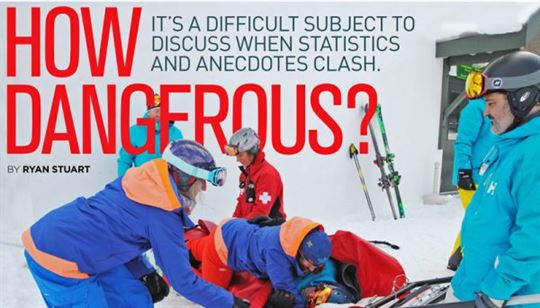How dangerous is skiing? It’s a difficult subject to discuss when statistics and anecdotes clash.
by RYAN STUART in the December 2017 issue
The Globe and Mail reported in October that Alberta and Ontario skiers and snowboarders have less than a 1/20th chance of ending up in the E.R. with a brain injury than hockey players, or 1/12th that of rugby and football players. We like those odds. But when we followed up on the research, their quoted source didn’t know where the numbers came from. Hmm…
B.C. Injury Research and Prevention Unit, on the other hand, says we have the highest “rates” of hospitalization, but we pored over their data and found in creating “rates,” there’s an assumption that 100 per cent of the population skis.
An extensive Ontario coroner’s report on the 35 male and 10 female winter sports deaths between 1991 and 2012 collected reams of data (lumping tobogganing with skiing and snowboarding) and produced many curious results. For instance, six people died on a toboggan, five on a snowboard and, not surprisingly given our numbers, 34 on skis over those 21 years. Even more curious, while one terrain park user died in that time period, five cross-country skiers met their doom. Unfortunately, the biggest question was never addressed: How did head injury rates change as helmet use compliance went from 0-98 per cent over the 21 years?
Canadian ski resorts had 16.5-million skier-visits in 2015-16, 1,707 of whom ended up in hospital, reports the Canadian Ski Council and the Canadian Institute for Health Information (CIHI). Always morbidly curious about injuries and deaths in our sport and how it compares to other sports, we found as many questions as answers in the data.
While some of the hard numbers make sense, how they relate to each other is as clear as a whiteout in the alpine. For example, the studies compare different sports and activities but don’t break them down by total participants or perhaps, more important, hours spent doing the activities. (Think about it, we ski for six hours on an average ski day, but who toboggans that length of time or gets more than an hour of ice time playing hockey?)
Here are some numbers to spout at après-ski or chat about on your next chairlift ride, but we recommend reading them like you would a Facebook post from some guy named Vladimir, i.e. with a bit of skepticism.
THE NUMBERS
National Hospital Visits*:
Falls on ice 6,625
Cycling 4,513
ATV 3,046
Playground 2,101
Skiing/snowboarding 1,707
Animal riding 1,057
Hockey 787
Skating 720
Snowmobile 942
*Source: CIHI
Of the injured skiers:
1/3 female
2/3 male
********************************************
B.C. Leading ways to die skiing or snowboarding*:
41% avalanche
26% collision with ground, tree or person
17% fall from height
12% suffocation in tree well or snowdrift
*B.C. Coroner Service
********************************************
All Winter Sport Fatalities in Ontario, 1991-2012*:
Head injury, 53%
Multiple injuries, 24%
Thoracic injuries, 16%
Other and unknown, 6%
*Ontario Coroner’s Service
******************************************
Ontario Helmet use:
Coroner determined that had victims been wearing a helmet:
16% could possibly have survived
24% could probably have survived
36% would have survived
16% wouldn’t have survived
8% undetermined
*Ontario Coroner’s Service
